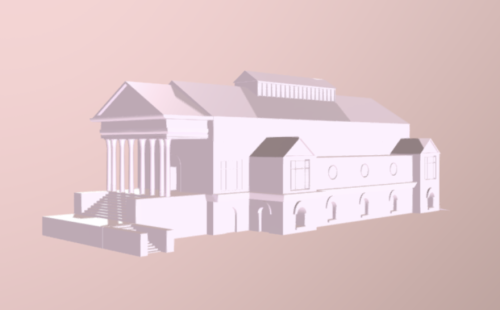Visual Resources
Come see our projects portal on OpenScholar HERE
Go HERE to browse our hosted collections on JStor

3D Digital Model of Fayerweather Hall

The Visual Resources Center (VRC) grew out of individual faculty slide holdings in the late 1960's, into a centralized departmental collection in order to more effectively and efficiently share resources and avoid duplication of effort. Our drive to provide the highest quality available images in support of the teaching and research mission of the University of Virginia continues today in our ongoing development of a digital image repository available to the entire University community.
Our Digital Image Collection includes more than 45,000 images and continues to grow. The creation of high-quality digital images to supplement standard collections allows the VRC to meet the changing needs of our patrons and frees them from the constrictions of published texts as they create their course content.
In 2007, the VRC partnered with ARTstor, a subscription based digital image database of more than a million images, to host our collection in a localized version of their digital library. This integrates the specialized content of our scholars into the broader collections already accessible, and provides a seamless interface for locating visual aids for teaching and research purposes. This local content continues to expand, and the Fiske-Kimball Fine Arts Library has since joined the VRC in hosting images with ARTstor. Our local collections, including the Department of Art ARTemis Archive, can be accessed on-grounds via www.artstor.org.
The VRC has three 3D printers. Victoria Valdes manages 3D projects and printing schedules, which are open on a first come first served basis. The VRC requests that you fabricate your model in CAD, Geomagic, Sketchup, Rhino or similar software and provide the .stl file on a flash drive or via Google Drive/Box/Dropbox for printing. If you have difficulty converting your file to .stl, please check with Victoria for further assistance.
- Prusa i3 MK3S. This is a high quality filament deposition manufacturing (FDM) machine capable of some beautiful prints. It is available only for faculty and graduate students - the length of print time is prohibitive for undergraduate classes, as each build takes several hours depending on the size. We recommend using the printer to create interactive learning tools such as architectural models, reproductions of statues/pottery/objects, and cutaways. Objects printed cannot exceed 25×21×21 cm, or about 8 inches high. If your project requires additional filament we are able to request restock at $25 a reel.
- Form2. This is a top of the line resin printer, capable of micron-exact prints. It has a smaller final print size than the Prusa, about 6" square. It can, however, print in a variety of materials, including wax (for lost-wax casting) and ceramic. Ceramic objects have a smaller size maximum as they are also quite heavy and can easily fail. Please contact Victoria prior to finalizing any plans for ceramic printing. We also recommend that your models be hollow in order to conserve material, which costs about $150 per liter. If a specific color resin is desired, the requestor will need to provide funding to purchase the color package.
- Form3. This is the most current version of the Form resin printers and has a slightly higher output quality as well as a faster print time. It is limited at this time to standard resin printing rather than experimental materials.
What can we do for you?
The staff of the Visual Resources Center can assist you in creating, accessing, and retrieving the highest quality images for your presentation, teaching, and research purposes. Some of the ways we can help are by:
- Familiarizing you with the image database ARTstor
- Working with you to develop the digital resources for your future courses
- Assisting you with strategic planning for your image needs, and developing a custom JStor Forum database to track your own scholarly images
- Taking digitizing requests from faculty members
- Training you to scan images following best practices, to use image editing tools, and to locate available scanning stations
- Pointing you to additional digital image resources
- Linking you to software and digital initiatives in an effort to augment teaching methods and the classroom environment.
The Slide Collection, an archive of 35mm slides numbering approximately 300,000, together with 2000 study-photographs, and 1000 lantern slides, is available for research purposes within the VRC during normal operating hours. Circulation of the analog collection, however, is restricted to faculty and graduate students of the Department of Art and the School of Architecture.
Access & Policies
Digital images are available to the greater University community; however, access to ARTstor and the VRC collection within it, is restricted to the University's computer network. The slide collection is available for circulation to faculty members and graduate students of the Department of Art and the School of Architecture. An orientation is advised.
Copyright Policy
All materials in the Visual Resources Center are subject to copyright restrictions. The Copyright law of the United States (Title 17, U.S. Code) governs the making of photocopies or other reproductions of copyrighted material. Under certain conditions specified in the law, libraries and archives are authorized to furnish a photocopy or other reproduction. One of these specified conditions is that the photocopy or other reproduction is not to be "used for any purpose other than private study, scholarship, or research." If a user makes a request for or later uses a photocopy or reproduction for purposes in excess of "fair use," that user may be liable for copyright infringement. This institution reserves the right to refuse to assist with or to supply a reproduction if, in its judgment, fulfillment of the request would involve violation of the copyright law.
